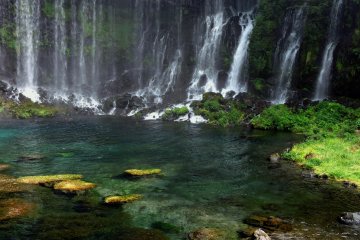At 3,776 meters above sea level, Mount Fuji or Fujisan is the highest and most famous mountain in Japan. It is located on the main island of Honshu on the borders of the Shizuoka and Yamanashi prefectures and, when the weather is clear, is even visible from Tokyo. It has been since 2013 part of the UNESCO World Heritage.
In 2025, there are some changes to hiking Mount Fuji:
- Trailheads will be closed to day hikers from 2pm until 3am and reservation documents (for a mountain hut) will be needed for any climbs starting after 2pm. This is to prevent speedy 'bullet climbs' that has seen hikers taking insufficient rest or caution.
- A mandatory fee of 4,000 yen per person is required to climb, and it is separate from the mountain hut fee. The hiking fee also applies to anyone descending the Yoshida Trail, if ascending via another route.
- To manage crowds, an online reservation system with 3,000 daily slots available opens in April, but 1,000 slots will still be available for same-day visits.
Mount Fuji is a stratovolcano on the Pacific Ring of Fire, which is classified as active, but with a low risk of eruption. Its last known eruption was in 1707 and lasted about two weeks. At the northern foot of the mountain are the five Fuji lakes.
In Shinto, Mount Fuji has been sacred for centuries and around it are more than 1,300 so-called Sengen shrines. The mountain also plays an important role in Buddhism, because in the so-called Shugendo, climbing a mountain is viewed as an expression of faith. Due to the strikingly symmetrical volcanic cone, Fuji is widely regarded as the most beautiful mountain in the world and is often viewed as a symbol of Japan. At the same time, it is a popular subject in Japanese art and can be found, among other things, in the famous woodblock prints by the artist Hokusai. Fuji is also the subject of many poems in literature.
Four hiking routes lead from different starting points to the summit of Mount Fuji: Yoshida Route, Subashiri Route, Gotemba Route and Fujinomiya Route. Climbing Mount Fuji is only permitted during the summer months from mid-July to mid-September; the routes and mountain huts are officially closed out of season.



/138.64895899755,35.312553612883,9/397x132?access_token=pk.eyJ1IjoiamFwYW50cmF2ZWxtYXBzIiwiYSI6ImNqbXBtOXYxbDB5Z3ozbHFrazJuYWMwOGYifQ.v15fy_mcFWtgopmz8PhwqA)